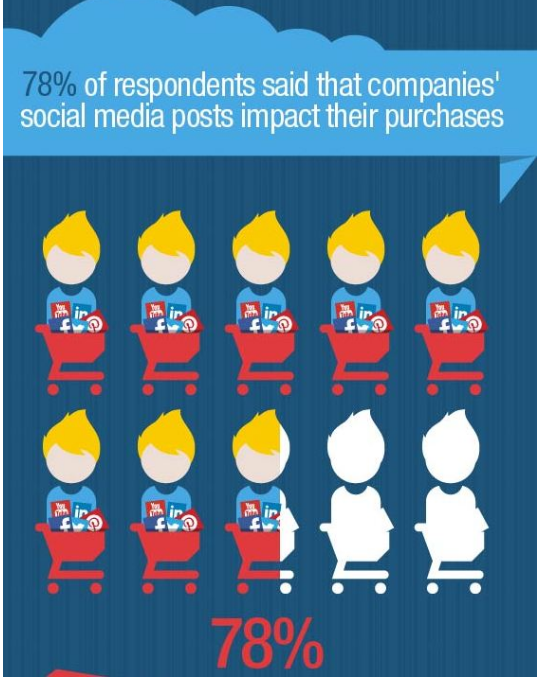Social media is a huge part of the world we live in currently, with users from all ages, backgrounds, and locations. It is recognised as one of the most powerful tools in terms of marketing (Kirtiş and Karahan, 2011). With the addition of E-WOM (E-word of mouth) this allows users to share experiences and exchange information instantly (Trusov, Bucklin & Pauwels, 2009). But how powerful is E-WOM through social media channels for influencing consumers?
Social media is a prominent channel for E-WOM as social media allows users to interact with each other instantly. When customers undergo a positive or negative experience they will usually share their opinions with friends, family, colleagues etc. Rather than waiting until when they next see them, they can post it on social media for all to see and react to. They can therefore freely express their experience and spread their opinions on a recent product or service they have used (Raacke and Bonds-Raacke 2008).
Looking at this graph; ‘reviews, comments and feedback’ has the highest votes from respondents, proving that word of mouth is seen as the most influencial source on social media activities when it comes to buyer behaviour. But why is listening to other people’s reviews and opinions the most influencial on social media?
A main factor in human communication is informing, meaning we like to discuss events or experiences that have happened to us in which the other person will register what has been said. When looking to purchase for example, a holiday, it’s rare that you would just look at a few pictures and think this is the one I’m going for! You would usually, look at a few reviews left by people who have been their previously and analyse whether the overall feedback is positive enough to make this your purchasing decision. Buyers will always naturally have suspicion and need further convincing whether they are making the right purchasing decision. Nielsen, (2013) discovered that 84% of consumers say they either completely or somewhat trust recommendations left by others regarding products and services. Proving how powerful word of mouth can be.
There can be risks to companies with E-WOM, for example, when some customers may share negative comments on a company’s products or services. For example, this Facebook status below:
The impact of this post will be that all their facebook friends who view their posts will now remember this certain venue to be bad and this may sway their future decision making when choosing a place to eat around this area. However, these negative postings can have potential to be resolved, by companies responding quickly to the negativity and responding calmly and politely. The consumers who have previously read the posting and been left with negative impressions could now be swayed and left a more posistive impression.
Even though there are risks which cannot be avoided, there are many benefits of E-WOM in social media. Social Media Today, (2015) discovered that 71% of consumers are likely to purchase items based on recommendations on social media. Additionally, a survey carried out by Invespcro, (2017) resulted in 78% are influences in purchasing decisions by social media posts. It’s clear how much impact e-WOM and social media can have when consumers and looking to purchase items or services. In addition, e-WOM via social media creates brand awareness due to discussions and sharing of experiences of the company’s product or service and therefore all other connected users can become aware of their brand. The best part is the company does not even have to spend a penny on marketing costs in order to do this, this is all done by consumers.
Additionally within this study they found that 81% have used recommendations from friends and family to impact their buying decisions. So combining the power of social media has on purchasing decisions and the power of WOM from friends and family makes this a very influencial factor of marketing.
Key points to takeaway:
- The power of E-WOM in social media should never be underestimated.
- It has a huge influence on decision makings and can create brand awareness.
- It is a form of marketing that your consumers do for you, however this can leave positive or negative outcomes.
- There is potential to tackle negative opinions and postings on social media
References
Invespcro, (2017). How Social Media Influences Purchase Decisions – Statistics And Trends [Infographic] | The Invesp Blog. [online] Invespcro.com. Available at: http://www.invespcro.com/blog/social-media-influences-purchase-decisions/ [Accessed 27 Mar. 2017].
Kirtiş, A.K. and Karahan, F. (2011) ‘To be or not to be in social media arena as the most cost-efficient marketing strategy after the global recession’, Procedia – Social and Behavioral Sciences, 24, pp. 260–268
Nielsen, (2013). Under the Influence: Consumer Trust In Advertising. [online] Nielsen.com. Available at: http://www.nielsen.com/us/en/insights/news/2013/under-the-influence-consumer-trust-in-advertising.html [Accessed 26 Mar. 2017].
Raacke, John and Jennifer Bonds-Raacke (2008), “MySpace and Facebook: Applying the Uses and Gratifications Theory to Exploring Friend-Networking Sites,” CyberPsychology & Behavior, 11 (2), 169-174.
Social Media Today, (2015). Is Social Media the Biggest Influencer of Buying Decisions?. [online] Social Media Today. Available at: http://www.socialmediatoday.com/marketing/masroor/2015-05-28/social-media-biggest-influencer-buying-decisions [Accessed 27 Mar. 2017].
Trusov, M., Bucklin, R.E. and Pauwels, K. (2009) ‘Effects of word-of-mouth versus traditional marketing: Findings from an Internet social networking site’, Journal of Marketing, 73(5), pp. 90–102. doi: 10.1509/jmkg.73.5.90.


